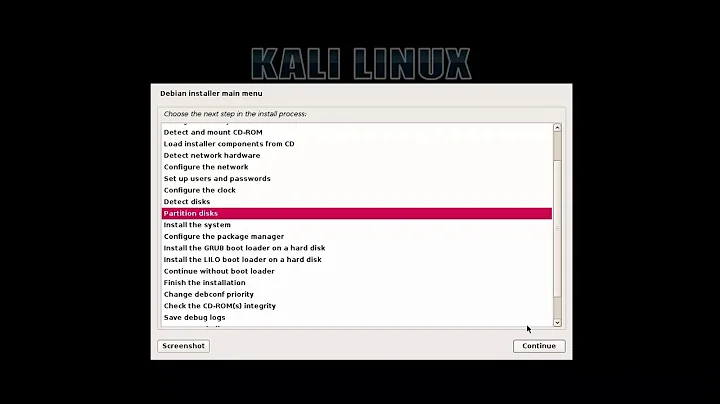Question regarding linux installation (Kali Linux (Debian Based)
Solution 1
RE step 6. There is nothing wrong with letting the installer take care of the partitioning for you. But remember not all distro's will set-up partitions in the same way. Some may create a separate root, /home and swap. Others may only create root and swap, bundling your root and home on the same partition. It is generally considered best practice to have /home on a separate partition. If the root partition becomes corrupted or otherwise inaccessible your data in home is still safe.
If your concerned about manual partitioning you could practice in a Virtual Machine. Manual partitioning isn't that scary once you've done it a couple of times. Something like 15GB for root, Double the installed RAM for swap and the rest for home is the scheme I generally follow for most set-ups.
When it comes to forensic distros It maybe better to boot from a USB or optical media and save data to a separate USB stick. Any good forensic distro will not allow write operations to the HDD that is being examined to prevent overwriting or corrupting evidence.
I'm sorry I cannot offer advise about where to install grub on a dual boot system. I prefer to use VMs as I don't have to reboot to change OS.
Solution 2
The official documentation describes how to set up a Kali/Windows dual boot system. The steps are more or less what you describe; for steps 1–2, the documentation shows how to use Kali as a live system (some distributions have it integrated into their installer, but Kali is less targeted at beginners).
If you want guided partitioning, then select guided partitioning instead of manual partitioning at step 4.
It's difficult to follow what you're saying about that article, without seeing the actual article. There is rarely any reason to change the default bootloader setup unless you have multiple Linux installations. Just select the default, with Grub as the main bootloader (in the boot sector). When you boot, Grub will show a menu to let you select between Kali and Windows.
Solution 3
There isn't any big difference on selecting YES or NO for installing the GRUB in the MBR. But if you are new to linux or dual booting there is a greater chance that you'll break your linux installation.
If you went with installing the GRUB in the MBR and you break your linux installation you won't be able to boot into windows too so you'll stuck here. And if you selected NO for the GRUB installation and you break your linux installation you'll still be able to use your windows OS.
Although you can recover your GRUB by using live linux bootable media or repair windows startup in case you aren't able to use windows. But it would be somewhat irritating.
Related videos on Youtube
Omer Iqbal
Updated on September 18, 2022Comments
-
Omer Iqbal over 1 year
Please tell me that following steps will help me in installing Kali Linux dual boot with windows?
- If I have 500GB and windows is taking all of it. I will create 100GB for Kali Linux by shrinking C.
- After that a 100GB will be as unallocated space.
- I'll boot into kali linux (through USB) and choose Graphical Install.
- In partition disks section, I'll choose Manual and click on Continue.
- Then it will show me 2 or 3 partitions (one will have 400GB and the other will have 100GB). I'll choose the 100GB.
- After it will ask me that how to use this space. I will choose Automatically partition the free space instead of choosing create new partition. I hope that choose automatically partition the free space won't ask me anything to enter amount for swap etc.
- After those steps, It will show me Yes and No options...
The main question is in 6th point that is, If I choose automatically partition the free space. Then It will do everything automatically in that 100GB? like creating swap etc. It's so confusing if I do it manually that's why I am asking.
I want that windows will be on 400GB partition and the linux will be on 100GB partition and it should automatically manage the partition for linux.
I was reading an article regarding to Dual booting kali with windows 7. In that the author chose NO option at the GRUB Boot loader to the master boot record. But I think I should choose YES. The author after choosing NO, manually typed
/dev/sda5in device for boot loader section.He said:
By default, the installer will want to install GRUB, the boot loader, in the Master Boot Record (MBR). However, for setting up this dual-boot system, we want GRUB in the boot partition. So, select “No.” Continue.
I don't think that Choosing YES will cause any problem. In that way too it will ask me to boot into the OS i want then Why I should follow the one shown in the article (of that author) and make everything confusing
Please tell me that by following the above steps, I'll be able to install kali linux dual boot with windows or there will be any problem ?




